Soyuz MS-02 mission (original) (raw)
Mission of Soyuz MS-02 spacecraft
Originally scheduled for launch on Sept. 23, 2016, the Soyuz MS-02 spacecraft was hit with a mysterious short circuit in September, which required postponing the mission indefinitely. After pinpointing the problem to an improperly bent cable located behind cosmonauts seats in the descent module, Russian engineers had to repair the vehicle loaded with toxic propellants and pressurized gases despite existing safety rules prohibiting such operations. The mission finally lifted off on Oct. 19, 2016. The Soyuz MS-02 carried three members of Expedition 49 to the ISS.
Previous Soyuz mission: Soyuz MS-01
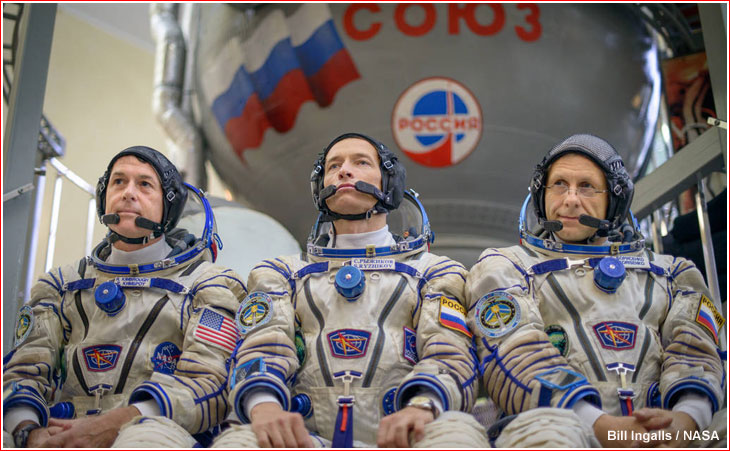
Soyuz MS-02 crew during training in Star City: NASA astronaut Shane Kimbrough and Russian cosmonauts Sergey Ryzhikov and Andrey Borisenko.
From the publisher: Pace of our development depends primarily on the level of support from our readers!
Soyuz MS-02 mission at a glance:
| Spacecraft | Soyuz MS-02 (11F732 No. 732) |
|---|---|
| Launch vehicle | Soyuz-FG R15000-059 |
| Launch site | Baikonur, Site 31, Pad 6 |
| Crew | Sergey Ryzhikov, Andrey Borisenko, Shane Kimbrough (ISS Expedition 49/50) |
| Launch date and time | 2016 Oct. 19, 11:05:14.378 Moscow Time (Postponed from 2016 Sept. 23, 21:17 Moscow Time) |
| Docking at ISS | 2016 Oct. 21, 12:52 Moscow Time (Orbit 34) |
| Landing | 2017 April 10, 14:21 Moscow Time; (originally planned: 2017 Feb. 26) |
| Flight duration | 173 days (actual); 130 days (originally planned) |
Soyuz MS prepares to fly
On September 17, Roskosmos announced that after final tests of the spacecraft, its launch had to be postponed from September 23. The new launch date has not been announced. According to industry sources, the delay was caused by a short circuit, which took place during roll-on of the payload fairing on Sept. 15, 2016, which protects the spacecraft during its ascent through the atmosphere. The problem was not detected until the vehicle had been rotated back to a vertical position and was being prepared for the second fit check at Site 254 in Baikonur. The situation was complicated by the fact that engineers could not immediately identify the location of the short circuit in the fully assembled spacecraft. Preliminary estimates indicated that such an issue inside the descent module, SA, could require several weeks to fix, however if the problem was in the instrument module, PAO, it could take several months to resolve.
In the worst case scenario, mission officials might decide to replace the Soyuz vehicle No. 732, which was affected by the problem, with Vehicle No. 733 originally intended for the Soyuz MS-03 mission. According to official Russian media, the launch of the Soyuz MS-02 might be postponed until at least the beginning of October.
On September 19, the Interfax news agency reported that a meeting of the State Commission overseeing the launch was scheduled at the end of the day to make a decision on how to proceed. In the meantime, the three members of the Soyuz MS-02 crew, including Russian cosmonauts Sergey Ryzhikov, Andrey Borisenko and NASA astronaut Shane Kimbrough who were already in Baikonur in preparation for the Sept. 23 liftoff, were now expected to fly back from Baikonur to their training center in Star City near Moscow.
On September 20, Interfax reported that the launch of Soyuz MS-02 had been preliminary penciled for October 12 or November 1, 2016. According to the agency, the delay of the mission could affect the downstream ISS schedule, including the launch of the Progress MS-04 cargo ship slated for Oct. 20, 2016, and the liftoff of the Soyuz MS-03 transport spacecraft scheduled for November 16 of the same year was now not expected to fly until December.
The return of the Soyuz MS-01 spacecraft, originally scheduled for October 30, 2016, could also be postponed, because the upcoming expedition was expected to overlap with the returning crew for at least a week for smooth transfer of duties aboard the orbital outpost, Interfax reported.
On September 22, the official TASS news agency reported that the culprit in the technical failure aboard Soyuz had finally been isolated to a burned cable, which could be replaced by October 19, enabling the launch in the last decade of the same month. According to flight ballistic experts quoted by RIA Novosti on September 21, the launch window was available from October 12 to October 20, 2016. In case Vehicle No. 732 could not be prepared for launch during this window, the follow-on spacecraft No. 733 could be ready for flight as early as November 1, the agency said.
Sources close to investigation told RussianSpaceWeb.com that a cable located behind the cosmonaut seats inside the Descent Module of the Vehicle No. 732 had accidentally been bent severely enough to damage its insulation. As it turned out, the problem had nothing to do with the encapsulation of the spacecraft inside its payload fairing on September 15, as was initially thought.
Replacing the damaged cable is relatively straight forward, but it now has to be conducted on the vehicle fully loaded with toxic propellants and pressurized gases. Such an attempt would violate usual safety rules, but draining the spacecraft off its propellants and gases would likely be even more unprecedented and require lengthy repairs.
Flight program
A Soyuz-FG rocket was scheduled to launch the Soyuz MS-02 (No. 732) transport spacecraft with a crew of three from Baikonur to the International Space Station, ISS, on Sept. 23, 2016, at 21:17 Moscow Time.
Within a previous revision of the ISS schedule, the Soyuz MS-02 mission was planned for Sept. 30, 2016.
The spacecraft was originally scheduled for landing on Feb. 25, 2017, at 08:05 Moscow Time.
By Sept. 26, 2016, ISS officials considered following provisional schedule in the wake of Soyuz MS-02 delays:
October 7: The crew return to Baikonur;
October 8: The final crew training and spacesuit fit check;
October 14: The Progress MS-02 cargo ship undocking and deorbiting;
October 19: The Soyuz MS-02 launch.
On Oct. 6, 2016, the State Commission overseeing the launch certified the results of the spacecraft repairs and approved the new launch manifest for the Russian missions to the ISS:
October 19, 11:05 Moscow Time: The Soyuz MS-02 launch;
October 30: Landing of the Soyuz MS-01 spacecraft;
November 16: The Soyuz MS-03 launch;
December 1: The Progress MS-04 launch.
On Oct. 8, 2016, the Soyuz MS-02 primary and backup crews made a rare repeat of the familiarization training with their fully assembled spacecraft inside the processing building at Site 254 in Baikonur. The procedure included suiting up operations, spacesuit pressure checks, boarding the spacecraft for tests of communications gear and other equipment and going over the instructions provided for the crew during the original rehearsal in September.
On October 10, Soyuz MS-02 was re-attached to a transfer ring, which serves as an interface between the spacecraft and the launch vehicle. The next day, or nearly a month after the technical problem had forced to halt preparations for flight, engineers repeated the final inspection of the Soyuz MS-02 spacecraft and it was then placed under its payload fairing.
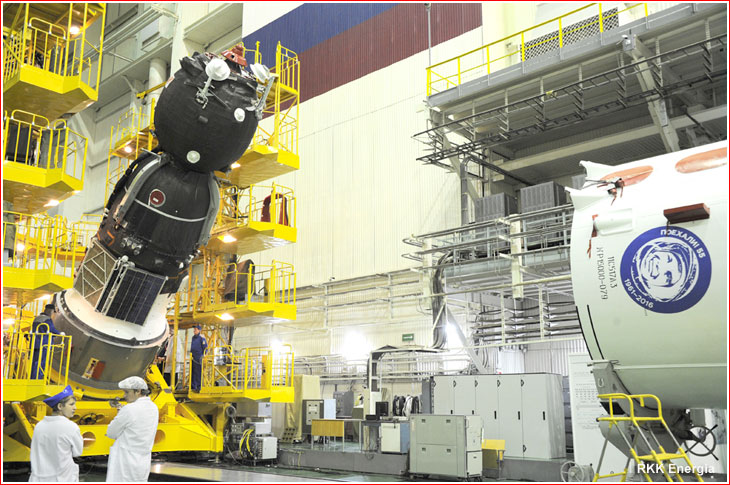
Soyuz MS-02 is rotated into horizontal position on Oct. 11, 2016, for the encapsulation into its payload fairing.
On October 13, the payload section containing the Soyuz MS-02 spacecraft was transported from its processing center at Site 254 to the vehicle assembly building at Site 31. Shortly before the departure of the payload section, the primary and backup crews again sat inside the spacecraft, reviewing control panels and testing various systems, including communications, RKK Energia said.
On October 14, at Site 31, the payload section was integrated with the third stage of the Soyuz-FG rocket and then the resulting stack was attached to the first and second-stage booster combination.
The State Commission overseeing the launch cleared the vehicle for the rollout to launch pad No. 6 at Site 31 on October 16, 2016, RKK Energia announced.
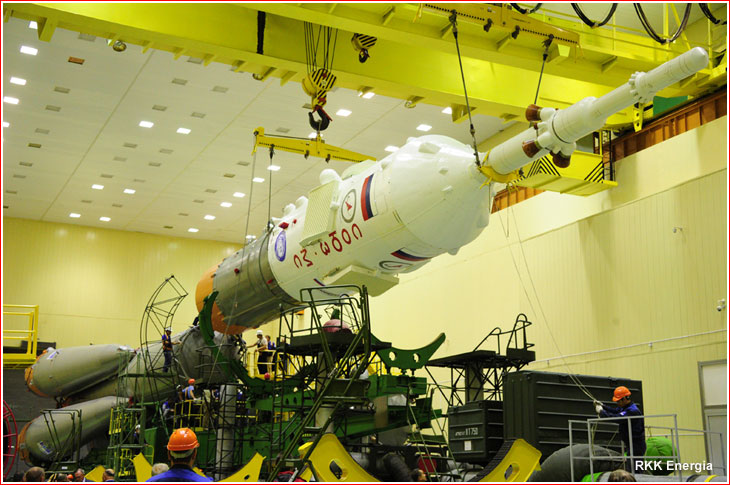
The final integration of the Soyuz-FG launch vehicle with the Soyuz MS-02 spacecraft on Oct. 14, 2016.
The Soyuz FG launch vehicle with the Soyuz MS-02 spacecraft was rolled out to Pad 6 at Site 31 in Baikonur on the morning of October 16, 2016.
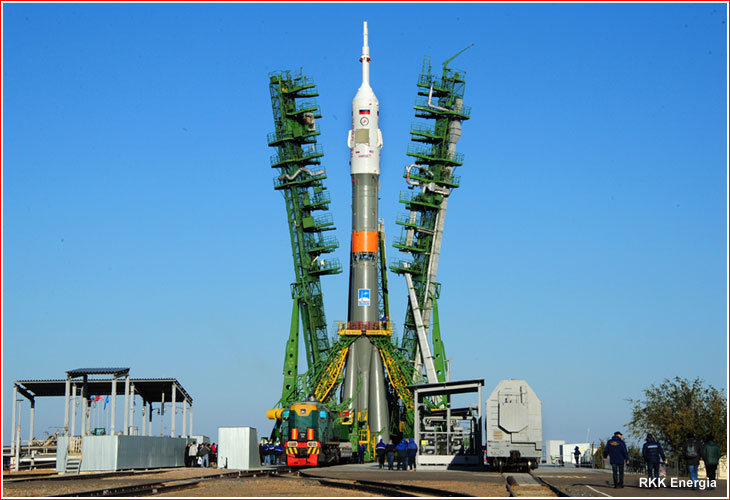
Soyuz MS-02 shortly after arrival to launch pad on Oct. 14, 2016.
Finally the launch!
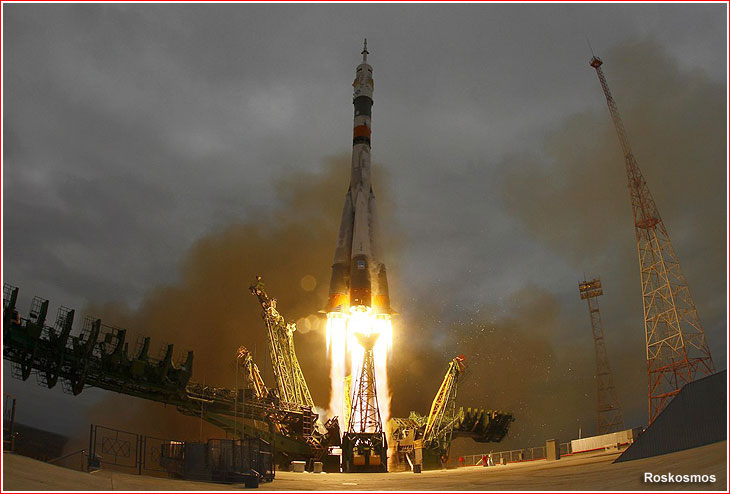
After a month-long delay, a Soyuz-FG rocket lifted off on Oct. 19, 2016, at 11:05:14.378 Moscow Time (4:05 a.m. EDT).
The launch vehicle carried the 7,220-kilogram Soyuz MS-02 spacecraft with a crew of three bound to the International Space Station, ISS. During the launch, the Soyuz Commander Sergey Ryzhikov occupied the central seat in the descent module, with Flight Engineer Andrey Borisenko to his left and NASA astronaut Shane Kimbrough, also Flight Engineer, in the starboard seat.
Propelled by the simultaneous thrust of the four engines of the first stage and the single engine of the second stage, the rocket headed east to align its ascent trajectory with an orbital plane inclined 51.66 degrees toward the Equator. Slightly less than two minutes into the flight, the ship's emergency escape system was jettisoned, immediately followed by the separation of the four boosters of the first stage. The second (core) stage of the booster continued firing for less than five minutes into the flight. Almost exactly 40 seconds after the separation of the first stage, the payload fairing protecting the spacecraft in the dense atmosphere split into two halves and fell away. Moments before the second stage completed its firing 4.7 minutes into the flight, the four-chamber engine of the third stage ignited, firing through a lattice structure connecting two boosters. Moments after the separation of the core booster, the tail section of the third stage split into three segments and fell away.
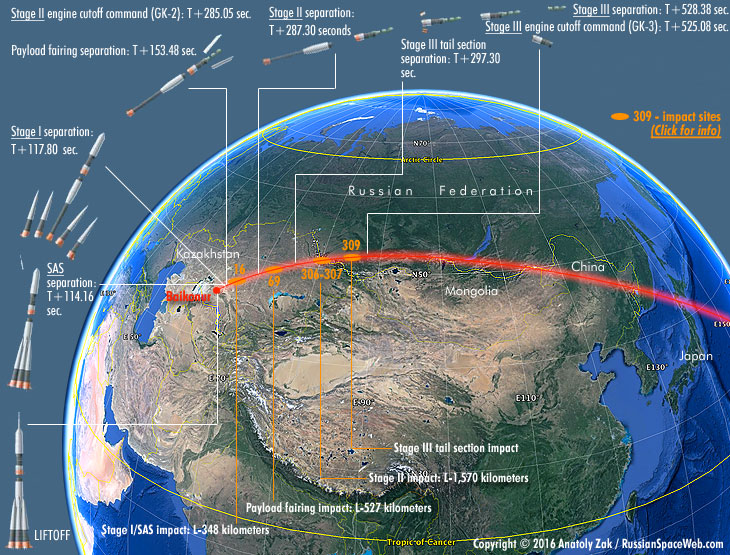
The Soyuz MS-02 launch sequence on Oct. 19, 2016.
The separation of the Soyuz MS-02 from the third stage of the launch vehicle took place as scheduled at 11:14:02.38 Moscow Time (4:14 a.m. EDT) into an orbit with the following parameters, according to the mission control in Korolev, Russia:
| Parameter | Planned orbit | Actual orbit |
|---|---|---|
| Orbital period | 88.64 minutes (+/-0.367) | 88.64 minutes |
| Inclination | 51.66 degrees (+/-0.058) | 51.66 degrees |
| Perigee (lowest point) | 200 kilometers (+7/-22) | 200.22 kilometers |
| Apogee (highest point) | 242 kilometers (+/-42) | 242.42 kilometers |
Without any additional maneuvers, the spacecraft would remain in this orbit for around 20 revolutions around the Earth during the next 30 hours, before reentering the Earth's atmosphere.
Soyuz MS-02 docks at ISS
Upon reaching its planned orbit, Soyuz MS-02 was 289 degrees away and below the ISS, which at the time was circling the planet in the 402.32 by 426.73-kilometer orbit.
According to NASA, the two-day rendezvous profile with the station, (as opposed to the six-hour scenario possible in Soyuz docking missions) was chosen to allow more tests of new systems on the Soyuz MS series.
According to the Russian mission control in Korolev, the Soyuz was scheduled to perform three orbital maneuvers during the 3rd, 4th and the 17th orbit of the flight, which would bring the spacecraft into the vicinity of the station, according to the following planned timeline:
| Orbit No. | Time, MSK | Firing duration | delta V | Orbital period | Inclination | Resulting perigee | Resulting apogee |
|---|---|---|---|---|---|---|---|
| October 19 | |||||||
| 3 | 14:46:01 | 62.1 seconds | 24.88 m/s | 89.48 minutes | 51.64 degrees | 225.31 kilometers | 284.49 kilometers |
| 4 | 15:41:49 | 63.8 seconds | 25.76 m/s | 90.38 minutes | 51.62 degrees | 259.79 kilometers | 348.06 kilometers |
| October 20 | |||||||
| 17 | 12:16:22 | 28.9 seconds | 2.00 m/s | 90.45 minutes | 51.65 degrees | 266.18 kilometers | 347.41 kilometers |
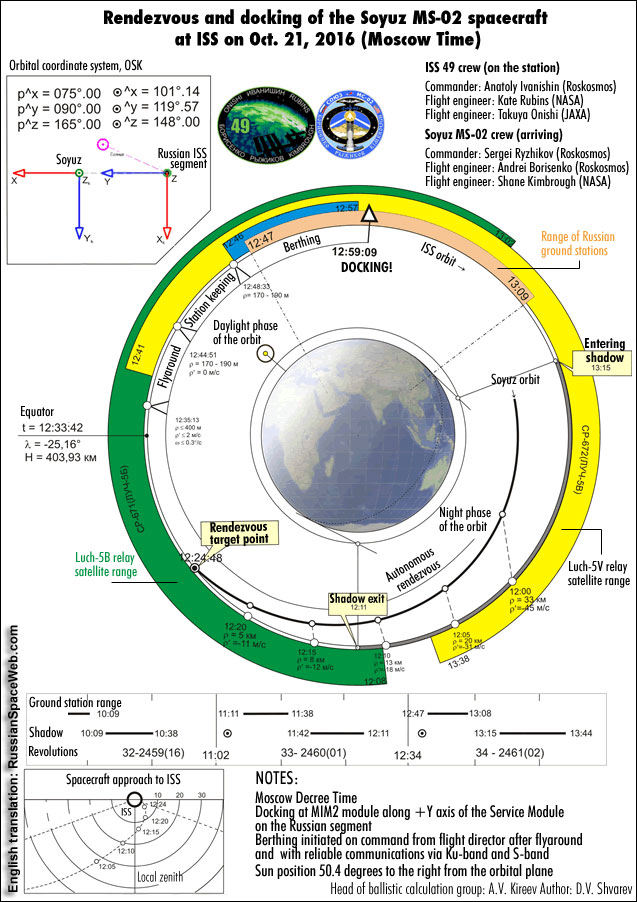
Following its orbit corrections, Soyuz MS-02 was expected to begin an autonomous rendezvous with the ISS around 10:34:48 Moscow Time on Oct. 21, 2016, (3:34 a.m. EDT), aiming to lock sensors of its Kurs-NA rendezvous system onto the station.
The final maneuvers, including a flyaround of the ISS, a short station-keeping period and berthing were to commence at 12:35:13 Moscow Time.
The docking of the Soyuz MS-02 spacecraft was originally scheduled on October 21, 2016, at 12:59:09 Moscow Time (5:59 a.m. EDT), during the 34th orbit of the mission, however in reality, it took place several minutes earlier at 12:52 Moscow Time (5:52 a.m. EDT).
The transport ship docked at the sky-facing docking port of the MIM2 Poisk module, the part of the outpost's Russian segment.
The hatch from Soyuz MS-02 to the ISS was opened around 8:20 a.m. EDT, around 15 minutes ahead of schedule.
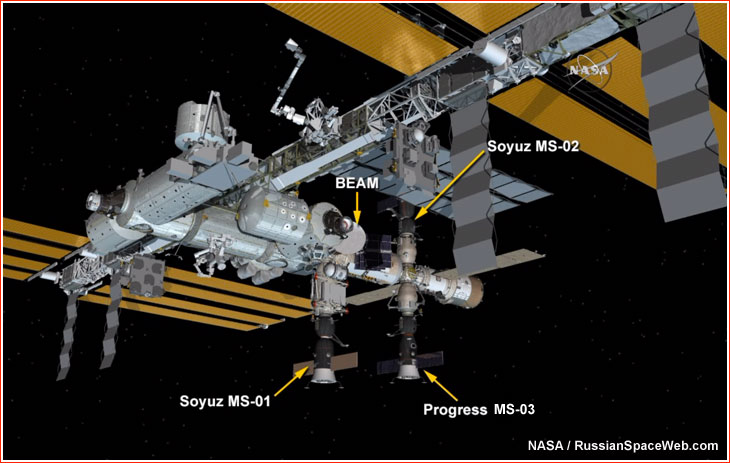
ISS configuration after the arrival of the Soyuz MS-02 spacecraft.
Soyuz MS-02 returns home
Russian cosmonauts Sergey Ryzhikov, Andrey Borisenko and NASA astronaut Shane Kimbrough returned to Earth, completing the 50th long-duration expedition onboard the International Space Station, ISS.
According to original plans, the crew was expected to work onboard the outpost for 130 days until Feb. 26, 2017, but in the course of the 50th expedition, the flight was extended to 173 days.
The landing of the Soyuz MS-02 spacecraft was scheduled for April 10, 2017, at 14:21:05 Moscow Time (7:21 a.m. EDT). The descent module was expected to touch down 147 kilometers southeast from the town of Dzhezkazgan in Kazakhstan at a point 47.8 degrees North latitude, 69.3 degrees East longitude.
In preparation for landing of Soyuz MS-02, six crew members aboard the ISS held a formal change of command ceremony on April 9, 2017. During the event, the commander of the Soyuz MS-02 crew Shane Kimgrough officially handed over the responsibility for the station to Peggy Whitson, who arrived on Soyuz MS-03.
Ryzhikov, Borisenko and Kimbrough boarded the Soyuz and hatches between their transport ship and the station were closed at around 07:45 Moscow Time on April 10, 2017. Ryzhikov was seating in the central seat of the descent module, with Borisenko to his left and Kimbrough in the right-hand seat.
Following the leak checks, Soyuz MS-02 undocked from the MIM2/Poisk module within the Russian segment of the ISS on April 10, 2017, at 10:57:30 Moscow Time (3:57 a.m. EDT). A command for undocking was issued a minute and a half before springs of the docking mechanism pushed the spacecraft away from the station.
After three minutes in solo flight, Soyuz MS-02 conducted two small maneuvers with its attitude control thrusters lasting eight and 15 seconds to increase its distance from the ISS.
The 4-minute 38-second deorbiting burn began at 6:28 a.m. EDT (13:28:30 Moscow Time), slowing down Soyuz MS-02 by 128 meters per second and pushing it into the Earth's atmosphere. According to the Russian mission control, the maneuver was to be completed at 13:33:04 Moscow Time.
Around 27 minutes later, (at 13:55:21 Moscow Time) at an altitude of 140 kilometes, the descent module with the crew separated from the habitation module and the instrument module of the Soyuz spacecraft. The descent module entered the discernable atmosphere three minutes later.
The parachute deployment process began 15 minutes before the scheduled touchdown with the opening of two pilot parachutes, followed by the drogue chute and concluded with the main parachute at 14:04:29 Moscow Time. The soft-landing engines of the descent module fired three seconds before the touchdown.
According to official Russian media, around 200 service members of the Central Military District were to be involved into the search and rescue operations, employing 14 Mi-8 helicopters, three An-26 and An-12 fixed-wing aircraft and 20 ground vehicles, including the Siniya Ptitsa ("blue bird") off-road evacuation vehicles. The search and rescue teams were deployed in Kazakhstan from the Sverdlovsk and Chelyabinsk Regions in Central Russia. The main search and rescue coordination center of the Soyuz MS-02 landing was set up at military operational headquarters of the 14th Army of the Air Force and Anti-aircraft Forces in Ekaterinburg. According to NASA, 12 helicopters were to be deployed around the primary landing site and a pair would be hovering near the backup site for a contingent ballistic landing.
NASA predicted ideal weather at the landing site, with southwesterly winds of around 10 knots, scattered clouds and temperatures in mid-60 degrees F.
According to NASA, the actual landing took place at 6:20:35 a.m. Houston Time, slightly ahead of schedule. Search and rescue vehicles provided spectacular live footage of the descent module landing under its parachute. Immediately after the touchdown, the spacecraft was pulled on its side by the parachute. Within three minutes, rescue teams reached the vehicle and rolled into the position for extraction. The crew members emerged from the descent module in the hands of rescue personnel around 14 minutes after the successful landing.
Following the departure of Soyuz MS-02, the ISS was to be occupied by three members of the Soyuz MS-03 crew Peggy Whitson, Oleg Novitskiy and Thomas Pesquet until the arrival of the Soyuz MS-04 spacecraft, following its liftoff on April 20, 2017. Soyuz MS-03 was scheduled to land on June 3, 2017, with Novitskiy and Pesquet onboard, while Whitson would remain onboard the ISS to return home on Soyuz MS-04 in early September 2017.
Next mission: Soyuz MS-03
This page is maintained by Anatoly Zak Last update:October 31, 2020
Page editor: Alain Chabot; Last edit: September 22, 2016
All rights reserved
